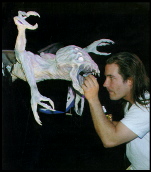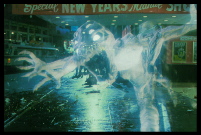
GHOSTBUSTERS REVISITED
...More elaborate means were used to produce two
monsters - one observed coming out of a movie theater and
a second terrorizing people in Washington Square. The
first - photographed at Apogee - was created by Rick
Lazzarini of [The Character Shop] in [Canoga
Park]. "The theater ghost was based on a drawing by
Henry Mayo. It had six eyes, four arms, two wings and a
forked tail. The head was nearly human-size and sculpted
by John Blake, while the body was made by Dan Frye. I
worked on the mechanics. Since the theater ghost was
added late to the film, we had only three weeks to build
and shoot the puppet."
To puppeteer the creature, Lazzarini employed an
interactive device he calls the 'facial Waldo.' "The
facial Waldo is a cap and vest system worn by an external
operator. Sensors are attached to the operator's face -
on the brows, cheeks, lips and jaw - and these sensors
link up to Ziff cards in the vest. Ziff cards were
invented by Stuart Ziff to enable radio control type
servos to be operated by direct wire - thus eliminating a
noisy radio link. in effect, they fool the servo into
thinking it is getting a command from a radio receiver.
On Ghostbusters II the Ziff cards received
information from the sensors on my face and head and then
sent signals to servos inside the creature. When I moved
my eyebrow or any other part of my lace, the theater
ghost did the same thing; and if I moved my head left or
right, the puppet did likewise. Since the theater ghost
had six eyes, it therefore had six eyebrows. To make it
simple, I had all six hooked up to the sensor on one of
my eyebrows so that when I moved my brow, all six moved
on the creature. This kept my hands free to puppeteer the
wings, and it also allowed me to do the performance of
the lace without having to plan it out using joysticks.
The facial Waldo really allows for a much more natural
performance."
Three additional puppeteers were required to operate
the tail and the four arms, Since the creature was shot
against black, Lazzarini and the other puppeteers wore
black beekeeper-style suits with black mesh lace screens
so they could see without being visible on film.


Left:
On stage at Apogee, Rick Lazzarini touches up a
mechanical creature he constructed for a montage shot
of a winged ghost flying out of a movie theater.
Facial articulation was accomplished via an
interactive device that translated expressions made by
an external operator directly to the puppet.
Right:
The Flying Ghost emerges from the theater.
In a single shot, the creature flies out of the
theater, leers at the fleeing crowd on the street and
then rushes at the camera. Even with the facial Waldo,
puppeteering the creature was still very difficult
because of the number of appendages involved and the
short length of the shot. "The real difficulty came after
we had rehearsed everything at half-speed to get the
moves down and then realized that forty-eight frames per
second was necessary to make the movements look smooth,"
recalled Sam Nicholson. "This meant that the puppeteers
had to do the moves two or three times faster - and all
within about two-and-a-half seconds. Also, to finish with
the creature's mouth just about covering the camera, we
had to shoot the whole thing in reverse. That put a real
strain on both the camera crew and the puppeteers." To
create a glowing effect, the creature's eyes were coated
with front-projection material. "We put a ring light on
the lens and then dialed up the intensity as we got
closer to the creature so it would really look like he
was coming at us. Having the eyes lit not only helped
increase the illusion of depth, but it also made the
creature seem more alive.
The ghost train sequence begins with the Ghostbusters
walking down the deserted subway tunnel in search of the
Van Home station. At first all is quiet, but then they
start hearing some ominous noises. Suddenly they find
themselves standing in the midst of the severed heads -
all shot 'live' on the set. In an instant, the heads
disappear and the threesome are again alone in the
abandoned tunnel. "We bought the heads all over town,"
said Gross. "We put out a 'dead head' call and found them
wherever we could. Pam Easley - our visual effects
coordinator - was zombie wrangler for that. Rick
Lazzarini made a few. We found a few. A prop house in New
York had a few. For the shot, we placed the better ones
in the foreground and the less detailed ones in the
background."
Article excerpt from CINEFEX
#40, © CINEFEX, 1991. Reproduced for review
purposes


